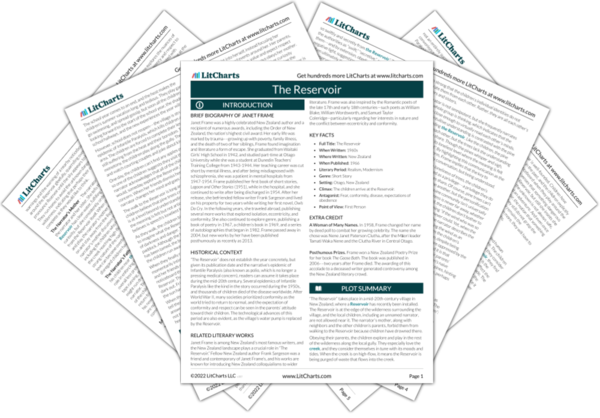The theme of control runs through “The Reservoir.” Frame repeats the phrase “for so long we obeyed” throughout the story to underline how much of the narrator’s life is spent following orders, and the first paragraph presents the idea that animals and children must show respect to adults. Setting animals and children on the same level dehumanizes the children, implying that they are like livestock that must be herded. The metaphorical connection between children and animals is strengthened when the children encounter a bull on their adventures. It has a ring in its nose, indicating that “its savagery was tamed,” and yet “it had once been savage and it kept its pride.” Although the bull has submitted to authority, it retains some independence.
Aligning independence with “savagery” extends the idea of obedience to a broader context, moving from children obeying their parents to societal disobedience in general. The narrator expresses some distrust of authority when describing the high-flow creek, which “conceal[s] beneath a swelling fluid darkness whatever evil which ‘they,’ the authorities, had decided to purge so swiftly and secretly from the Reservoir.” The description of the authorities as “swift,” “secretive,” and “evil” paints them––and by extension, obedience to them––in a distinctly negative light, suggesting that they shouldn’t be blindly trusted. When ultimately the children disobey their parents and explore the Reservoir, they assert their independence within a world that, on both a societal and familial scale, expects obedience. Such an assertion of independence, the story suggests, is a vital part of growing up.
Independence vs. Obedience ThemeTracker

Independence vs. Obedience Quotes in The Reservoir
[...] how important it was for birds, animals and people, especially children, to show respect! And that is why for so long we obeyed the command of the grownups and never walked as far as the forbidden Reservoir but were content to return ‘tired but happy’ (as we wrote in our school compositions) answering the question, Where did you walk today? with a suspicion of blackmail, ‘Oh, nearly, nearly to the Reservoir!’
And for so long we obeyed our mother's command, on our favorite walks along the gully simply following the untreated cast-off creek which we loved and which flowed day and night in our heads in all its detail [...] We knew where the water was shallow and could be paddled in, where forts could be made from the rocks; we knew the frightening deep places where the eels lurked and the weeds were tangled in gruesome shapes; we knew the jumping places, the mossy stones with their dangers, limitations, and advantages; the sparkling places where the sun trickled beside the water, upon the stones; the bogs made by roaming cattle, trapping some of them to death; their gaunt telltale bones; the little valleys with their new growth of lush grass where the creek had ‘changed its course,’ and no longer flowed.
Our lessons came by post, in smudged print on rough white paper; they seemed makeshift and false, they inspired distrust, they could not compete with the lure of the sun still shining, swelling, the world would go up in cinders, the days were too long, there was nothing to do, there was nothing to do; the lessons were dull; in the front room with the navy-blue blind half down the window and the tiny splits of light showing through, and the lesson papers sometimes covered with unexplained blots of ink as if the machine which had printed them had broken down or rebelled, the lessons were even more dull.
What is it? I wondered. They said it was a lake. I thought it was a bundle of darkness and great wheels which peeled and sliced you like an apple and drew you toward them with demonic force, in the same way that you were drawn beneath the wheels of a train if you stood too near the edge of the platform.
















